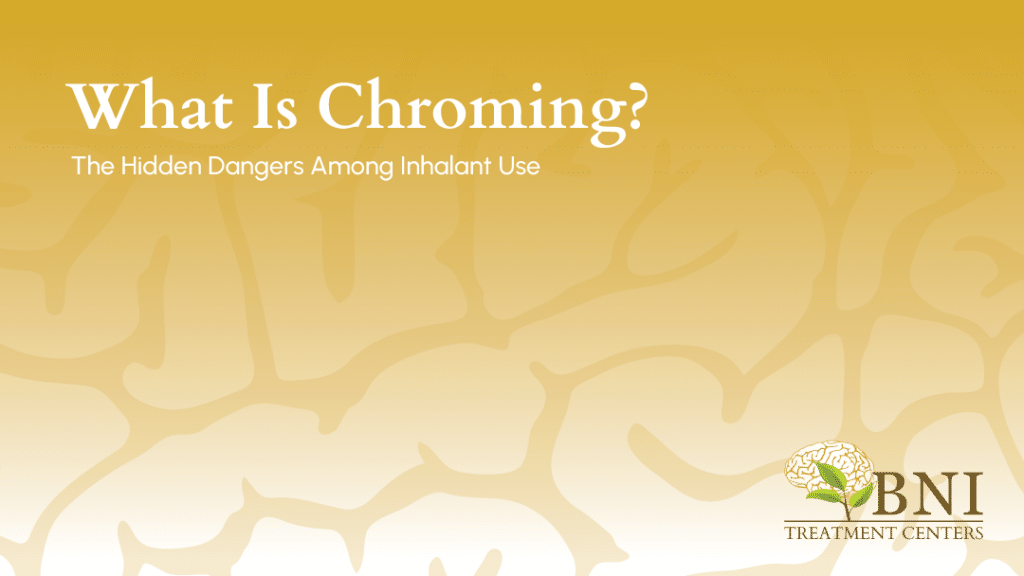
With all of the substances available both legally and illicitly, parents need to know what their teen has the possibility of trying. Chroming is the method of taking a chemical substance, such as spray paint, super glue, or solvents, and inhaling the fumes to obtain a euphoric experience. It is common among adolescents and teens due to the availability of these products for purchase or around the house. However, this can have serious consequences on their physical and mental health.
In today’s society, mental health is essential to overall well-being. In Los Angeles County, almost 35% of teens below age 17 are diagnosed with anxiety or a stress-related disorder this year alone. 26% have depression or a mood-related disorder such as bipolar disorder.
Teens attempt to manage their mental health by taking substances, including inhalants. BNI Treatment Centers provides education to parents about substance use and mental health, answering questions and providing a safe space for support and mental health treatment. In this article, we will discuss what chroming is and how to help your teen if they are developing an inhalant use disorder.
Understanding Chroming: Definition and Context
Chroming is a slang term originating from Australia. It refers to the inhalation of fumes from aerosol paints, although other products can also be used, such as adhesives, butane, gasoline, cleaning products, permanent markers, and nitrous oxide. The goal is to achieve a psychoactive effect similar to intoxication or the euphoria experienced when consuming marijuana. Although chroming is a relatively new term, the practice of inhalant use has existed for years and is often referred to as huffing, poor man’s pot, whippets, and hippie crack.
The experience of chroming has been described as pleasurable among adolescents. According to studies, the rush of euphoria and the intensity of the feeling are the main attractions that lead to continued use. In addition to these sensations, the products used for chroming are widely available and easy to obtain. Despite the requirement to be 18 years old in California to purchase aerosol paint and other products, these items are commonly found around the house due to parents’ purchases.
Physiological and Psychological Side Effects of Chroming
When an inhalant is consumed, the physical effects are immediate. These include exhilaration, dizziness, and in some cases nausea. The first initial rush is short-lived, lasting mere minutes. From there, the person will feel short-term effects for the next 30 to 60 minutes, including:
- Visual and auditory hallucinations
- Disorientation and confusion
- Inappropriate reactions, such as laughing in a serious moment
- Numbness throughout the body
- Drowsiness
- Incoherent speech
- Vomiting
After the effects of chroming wear off, the person will experience headaches and feel drowsy for a few hours. In some cases, seizures can result from chroming.
Psychologically, chroming results in mood swings, anxiety, depression, and in severe cases, hallucinations or delusions. Adolescents are more vulnerable to these effects as their brains are underdeveloped. This neurological disruption can cause lasting implications for academic performance, emotional regulation, and social relationships.

The Hidden Perils: Health and Safety Risks of Chroming
Chroming is often viewed as “safer” by adolescents as they see it as not technically an illicit substance. These assumptions are incorrect, and the health hazards and safety risks associated with inhalants are vast.
Common long-term side effects of inhalants include:
- Fatigue
- Chronic headaches
- Sinus problems
- Memory issues
- Diminished cognitive function
- Nosebleeds
- Shortness of breath
- Dizziness
- Stomach ulcers
Psychologically, chronic inhalant use has been shown to increase the occurrence of depression and anxiety. As with any substance use disorder, chroming leads to mental health changes that are often negative, resulting in mood swings and other undesirable emotions.
A serious side effect of chroming is known as “sudden sniffing death,” which can occur no matter how many times the person has used inhalants. The body becomes overwhelmed with the toxic vapors, and either asphyxiation or rapid heart rate is the consequence. This happens suddenly, and it is vital to seek medical attention immediately.
Identifying the Signs: Is Your Teen Engaging in Chroming?
Recognizing the signs of chroming is crucial for parents to understand. Both behavioral and physical indicators may suggest chroming and a possible inhalant use disorder. Common physical signs include chemical odors on the breath or clothing, paint or stains on the face and hands, and frequent nosebleeds or sinus complications. Headaches, nausea, or loss of appetite may accompany these symptoms.
Behavioral changes include mood swings, difficulties with school, disengagement from social activities, and increased secrecy. Items such as empty aerosol cans, plastic bags, or rags soaked in chemicals found among your teen’s belongings are strong indicators of chroming.
It is important to approach these signs with a balance of concern and understanding rather than immediate confrontation. Adolescents often engage in risky behaviors due to peer pressure, curiosity, or underlying mental health conditions. Building trust and maintaining open lines of communication are essential steps in addressing inhalant use effectively.
Opening the Dialogue: How to Talk to Your Teen About Chroming
Beginning the conversation with your teen often feels difficult, and as a parent, you may wonder where to start. The goal is for them to know you care and are concerned while alerting them to your fear for their safety and well-being.
Ask questions and actively listen to their responses. Even if you know about chroming, ask them if they have heard of it or know what it entails. Bring up the health hazards that are associated with it and how it can affect their future. Ask about their feelings and what is leading them to inhalant use. There is a high probability that they are looking for support or help with their mental health.
Offer alternative methods for coping with stress, anxiety, or peer pressure. Be there to provide support and options when needed. Having a supportive and informed home environment helps significantly reduce the risk of chroming and other forms of substance use.

Chroming Prevention and Mental Health Care for Teens in the Los Angeles Area
Whether chroming has happened only once or multiple times, teens are at high risk of developing an inhalant use disorder. The good news is that early intervention can be the crucial step needed to help teens overcome chroming. Therapy for teens is often the first line of defense, teaching them how to properly cope with their feelings and manage their emotions.
Besides therapy, medications may be a part of your teen’s treatment path toward better mental health. Conditions such as depression, anxiety, bipolar disorder, and more benefit from antidepressants, antipsychotics, and other medications. Your teen’s care team will be an active part of this process, ensuring they receive the proper care needed to move forward in life without inhalant use.
BNI Treatment Centers has been serving the Los Angeles area for years, providing quality mental health care for adolescents. Our facility is psychiatrist-owned, offering high-class treatment and therapies. We will help you get your teen on the path to success, educating them on healthy coping techniques and guided life skills training. Call us today at (888) 522-1504 to learn more.
BNI Treatment Centers: Science-based, evidence-backed, compassion-led.




